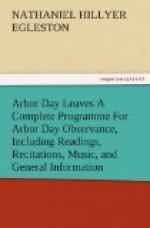=California.=—From Superintendent of Public Instruction: “Our schools cannot protect the forests, but they can raise up a generation which will not leave their hillsides and mountains treeless; a generation which will frown upon and rebuke the wanton destruction of our forest trees. There is no spot on earth that may not be made more beautiful by the help of trees and flowers.”
=Nebraska.=—From the State Superintendent of Public Instruction: “On this day, above all others, the pupils of our public schools should be educated to care for the material prosperity of the country and to foster the growth of trees. Let the child understand that he is especially interested in the tree he plants: that it is his; that upon him devolves the responsibility of protecting and cultivating it in coming years.”
=New York.=—Hon. A.S. Draper, ex-Superintendent of Public Instruction: “The primary purpose of the Legislature in establishing Arbor Day was to develop and stimulate in the children of the commonwealth a love and reverence for Nature, as revealed in trees and shrubs and flowers.”
THE BEST USE OF ARBOR DAY.
Arbor Day, to be most useful as well as most pleasant, should not stand by itself, alone, but be connected with much study and talk of trees and kindred subjects beforehand and afterward. It should rather be the focal or culminating point of the year’s observation of trees and other natural objects with which they are closely connected. The wise teacher will seek to cultivate the observing faculties of the pupils by calling their attention to the interesting things with which the natural world abounds. It is not necessary to this that there should be formal classes in botany or any natural science, though we think no school should be without its botanical class or classes, nor should anyone be eligible to the place of a teacher in our public schools who is not competent to give efficient instruction in botany at least.
But much may be done in this direction informally, by brief, familiar talks in the intervals between the regular recitations of the school-room, or during the walks to and from school. A tree by the road-side will furnish an object lesson for pleasant and profitable discourse for many days and at all seasons. A few flowers, which teacher or pupil may bring to the school-room, will easily be made the means of interesting the oldest and the youngest and of imparting the most profitable instruction. How easy also to plant a few seeds in a vase in the school-room window and to encourage the pupils to watch their sprouting and subsequent growth.
Then it should not be difficult to have a portion of the school grounds set apart, where the pupils might, with the teacher’s guidance, plant flower and tree seeds and thus be able to observe the ways and characteristics of plants in all periods of their growth. They could thus provide themselves with trees for planting on future Arbor Days, and at the time of planting there would be increased enjoyment from the fact that they had grown the trees for that very purpose.




